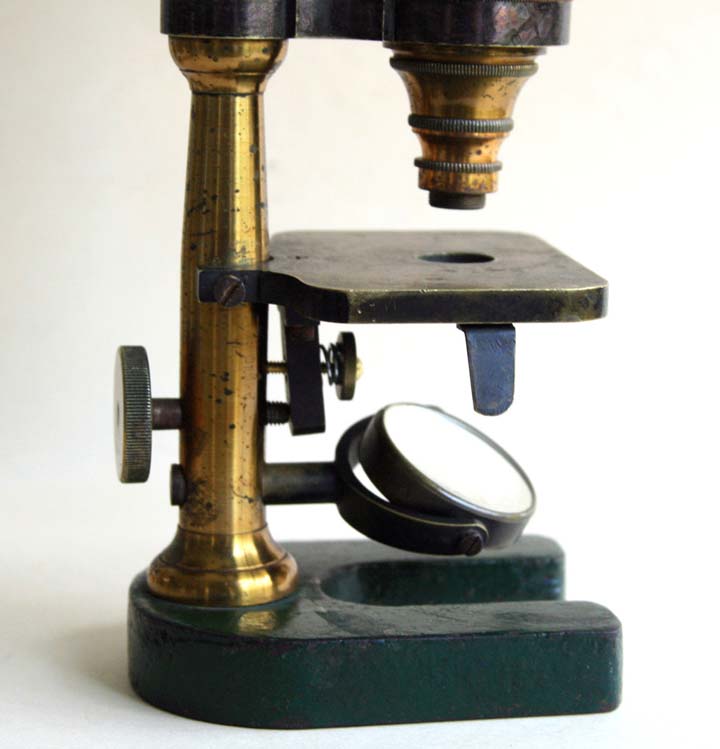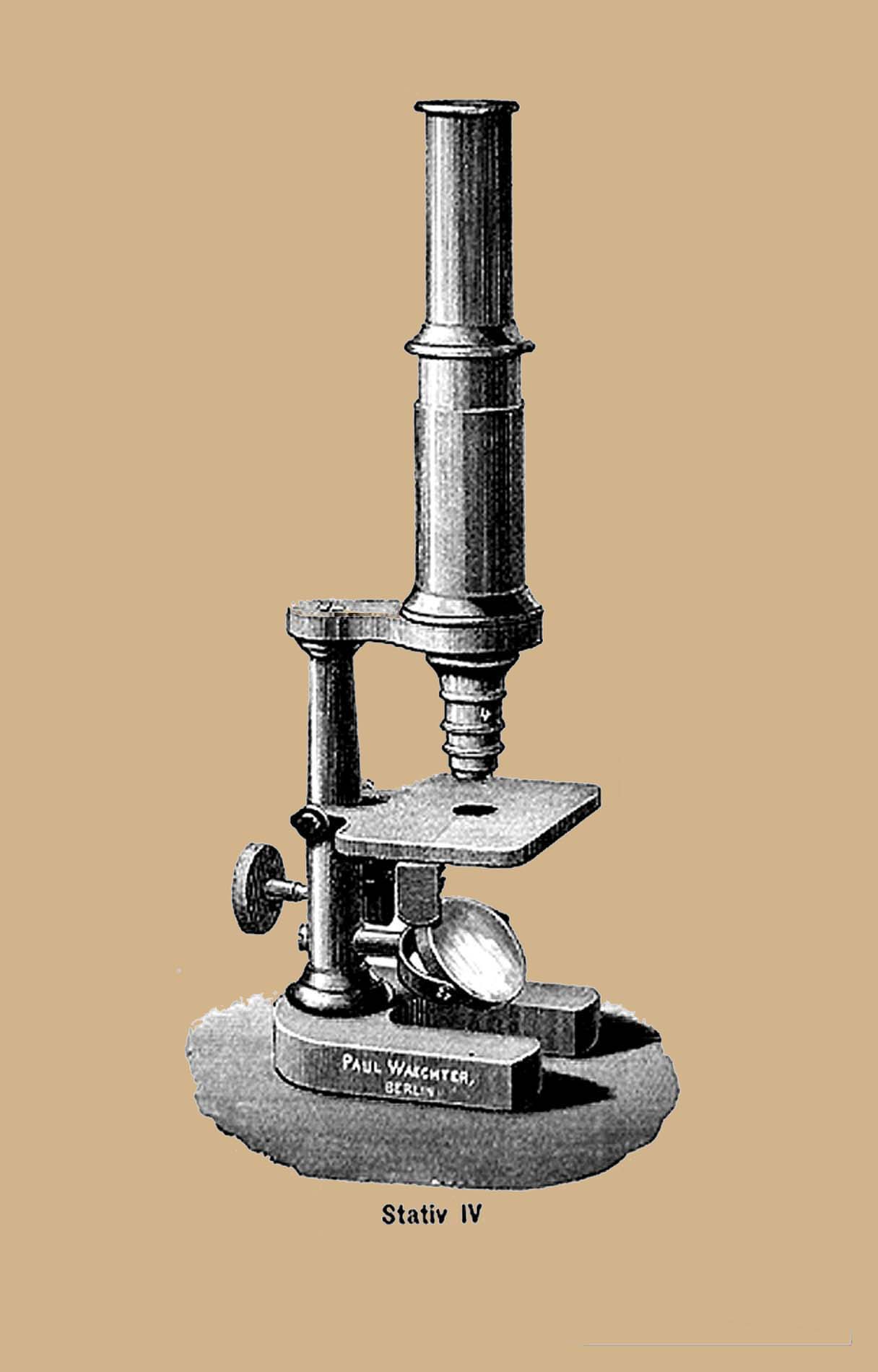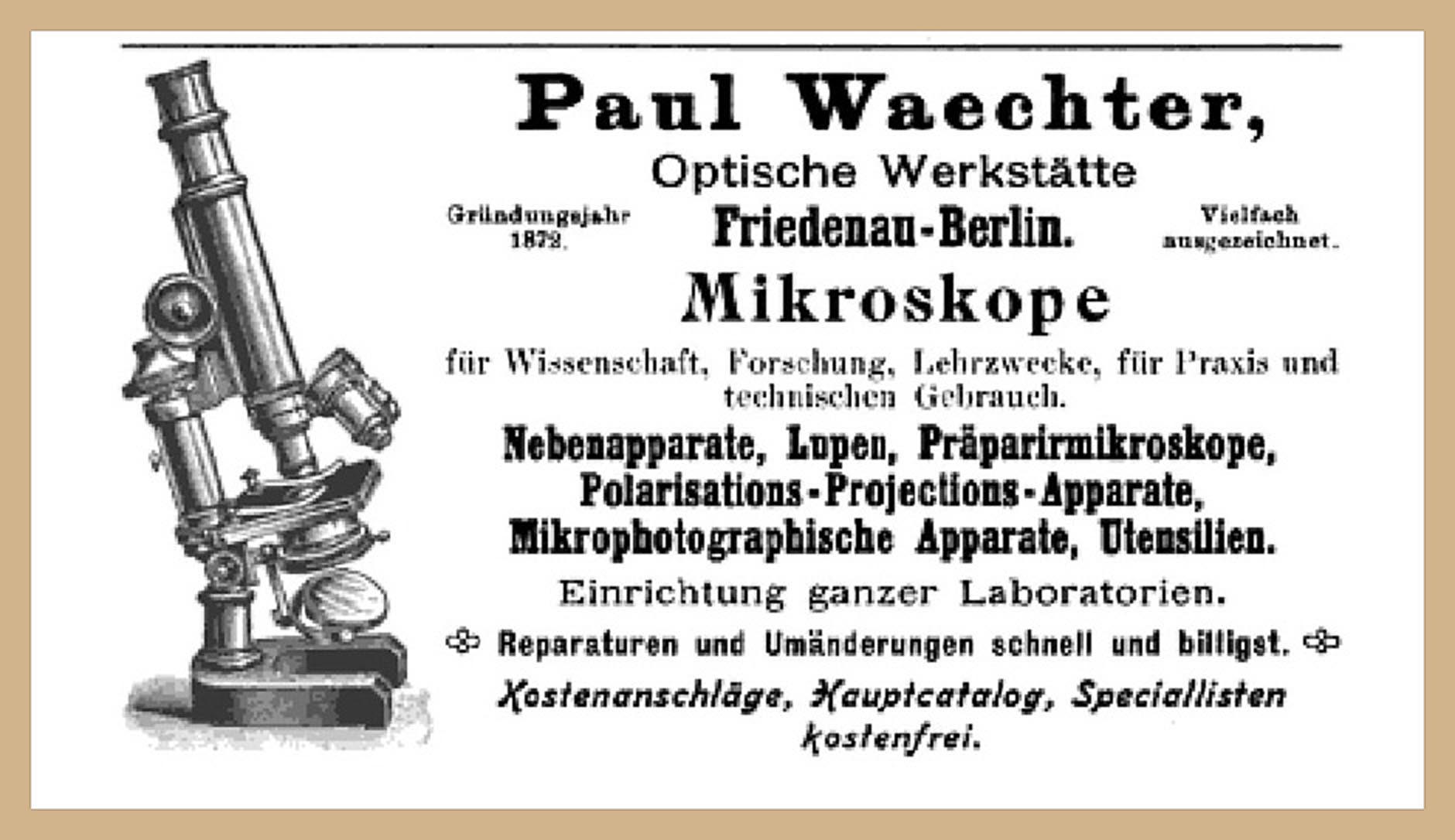MICROSCOPE-ANTIQUES.COM © 2013-15.
'STATIV IV (V) OR STAND #4 (5)MICROSCOPE':
c. 1890
Unsigned, but Clearly by Paul Waechter
Serial Number: None
DESCRIPTION
 This is a small, but heavy for its size, monocular microscope most
likely manufactured by the German optician, Paul Waechter, of Berlin,
Germany. It is about 11 inches tall in use. The stage is 3
X 2 inches. This is a Paul Waechter Stand IV (or V((Stativ IV or
V) microscope. This microscope is unsigned and does not bear a serial
number, but it is likely a Paul Waechter instrument, which is shown as
his Stativ IV/V microscope in his Microscope Catalog No. 14 published
in Berlin, Germany in 1889. This microscope is built upon a
conventional “Continental” design horseshoe shaped foot of green
painted metal. Rising from the foot is a tapered brass pillar that
supports the stage and the rest of the microscope including a bar limb,
a brass sleeve and the body tube. The rectangular stage of this
microscope is 55mm by 75 mm in size with a central aperture of 15mm
with a central stop of 6mm located below the top of the stage. Also
under the stage is a single aperture stop of 2mm that can be rotated in
or out of the light path with a hand lever located on the right side of
the instrument. There are no slide clips on top of the stage and no
provision is made for them. The stage is attached to the pillar with a
pair of set screws positioned approximately 60mm above the foot of the
microscope. This arrangement allows the stage to move slightly up or
down, pivoting on the setscrews. Below the stage is a 30mm diameter
plano-concave mirror that is attached on a brass stem that extends
through the pillar. Coarse focus is by moving the body tube of the
microscope up or down within a brass sleeve that is attached to the top
of the pillar with a bar limb. This microscope has a unique form of
fine focus. A spring loaded “T” shaped bar extends below the
stage. Extending through the pillar is a control knob that can be used
to exert pressure on the back of the brass bar. This action tends to
tilt the stage ever so slightly up or down to afford fine focus.
Despite the fact that it tilts the stage slightly from the horizontal
plane, it still is quite effective in providing fine focus for low
power work; for high power work it would change the illumination and
this would be a problem. The body tube of the microscope is of brass. A
single eyepiece (unmarked as to power, but estimated to be 10x by Bill)
is provided. At the base of the body tube is a single cone-shaped
objective lens. It is threaded at its bottom so it could have
taken another optical element to increase magnification, but works well
as is with about a 1 inch focal length. It is unmarked as to
manufacturer or power, but is presumed to be made by Waechter because
it is the shape of his objectives of the time. When the body tube is
racked all the way down, the microscope stands about 9.5 inches tall.
When the body tube is pulled all the way out, it stands about 11 inches
tall. The microscope weighs about 3 pounds. Another smaller but similar Waechter microscope is also in this collection, as is a Trichinascope.
This is a small, but heavy for its size, monocular microscope most
likely manufactured by the German optician, Paul Waechter, of Berlin,
Germany. It is about 11 inches tall in use. The stage is 3
X 2 inches. This is a Paul Waechter Stand IV (or V((Stativ IV or
V) microscope. This microscope is unsigned and does not bear a serial
number, but it is likely a Paul Waechter instrument, which is shown as
his Stativ IV/V microscope in his Microscope Catalog No. 14 published
in Berlin, Germany in 1889. This microscope is built upon a
conventional “Continental” design horseshoe shaped foot of green
painted metal. Rising from the foot is a tapered brass pillar that
supports the stage and the rest of the microscope including a bar limb,
a brass sleeve and the body tube. The rectangular stage of this
microscope is 55mm by 75 mm in size with a central aperture of 15mm
with a central stop of 6mm located below the top of the stage. Also
under the stage is a single aperture stop of 2mm that can be rotated in
or out of the light path with a hand lever located on the right side of
the instrument. There are no slide clips on top of the stage and no
provision is made for them. The stage is attached to the pillar with a
pair of set screws positioned approximately 60mm above the foot of the
microscope. This arrangement allows the stage to move slightly up or
down, pivoting on the setscrews. Below the stage is a 30mm diameter
plano-concave mirror that is attached on a brass stem that extends
through the pillar. Coarse focus is by moving the body tube of the
microscope up or down within a brass sleeve that is attached to the top
of the pillar with a bar limb. This microscope has a unique form of
fine focus. A spring loaded “T” shaped bar extends below the
stage. Extending through the pillar is a control knob that can be used
to exert pressure on the back of the brass bar. This action tends to
tilt the stage ever so slightly up or down to afford fine focus.
Despite the fact that it tilts the stage slightly from the horizontal
plane, it still is quite effective in providing fine focus for low
power work; for high power work it would change the illumination and
this would be a problem. The body tube of the microscope is of brass. A
single eyepiece (unmarked as to power, but estimated to be 10x by Bill)
is provided. At the base of the body tube is a single cone-shaped
objective lens. It is threaded at its bottom so it could have
taken another optical element to increase magnification, but works well
as is with about a 1 inch focal length. It is unmarked as to
manufacturer or power, but is presumed to be made by Waechter because
it is the shape of his objectives of the time. When the body tube is
racked all the way down, the microscope stands about 9.5 inches tall.
When the body tube is pulled all the way out, it stands about 11 inches
tall. The microscope weighs about 3 pounds. Another smaller but similar Waechter microscope is also in this collection, as is a Trichinascope.
I am grateful to both Bill Burnett, and Timo mappes for supplying some
of the description and information on the history of Waechter
instruments reported here and to Bill Burnett for allowing me to
reproduce his photographs of my instrument.
 HISTORY OF THE PAUL WAECHTER MICROSCOPES
HISTORY OF THE PAUL WAECHTER MICROSCOPES
Two versions of the models No. IV and V are in this collection, and No.
4. differed from No. 5 only in the optics with which they were
supplied.
Paul Waechter (1846 - 1893) was trained to be an optician and mechanic
at the famous Zeiss Optical Workshop in Jena, Germany. In 1872,
Waechter founded his own optical workshop at Köpnicker Strasse No. 115
in Berlin. In the year 1886, Waechter published advertisements for his
microscopes in the scientific literature that included the phrase,
“Student of Dr. Zeiss.” His earlier instruments were signed in script
on the body tube either, “Paul Waechter in Berlin” or more simply,
“Paul Waechter, Berlin.” By the year 1890, demand for his microscopes
had increased to such and extent that he moved his workshop to larger
facilities in Friedenau, Berlin, first at Albe Strasse 21 and then at
Nied Strasse 19. The company remained at Friedenau on into the early
years of the 20th Century. At this time, the usiness was named
'Optische Werkstaette Paul Waechter,' although Waechter died about
1893. Microscopes produced by the company during this period often did
not bear a signature or serial number on the microscope itself, but
this information was usually found on the the wood case that normally
accompanied the instrument, as it was for other makers like Schieck.
The serial number of the instrument was usually stamped on the lip of
the case and inside the lid of the case was a paper label bearing the
name of the manufacturer as Waechter along with a magnification table.
Between the years 1872 and 1892, Waechter produced over 20,000
microscopes, mostly for the examination of trichinae in meat. It was
the famous scientist, Rudolph Virchow (1821 – 1902) who, in circa 1870,
succeeded in inducing various German states to make compulsory the
testing of pork for Trichinosis in abattoirs (slaughter houses).
Waechter and several other German microscope manufacturers designed and
produced microscopes especially to meet this need. Many of these
instruments were exported outside of Europe including to the USA. An
advertisement shown here, is from the German periodical entitled,
'Zeitschrift fur Wissenschaftliche Mikroskopie und Mikroskopische
Technik,' which is available on the internet. By the mid-1930s, the
business was taken over by the Pridat family and the optical workshop
was moved from Berlin to Potsdam in what is now the nation of Poland
(formerly the German State of Prussia).
I am grateful to Bill Burnett who originally sold me this instrument,
for allowing me to include part of his descriptive details and his
photographs of my instrument on this site.






 This is a small, but heavy for its size, monocular microscope most
likely manufactured by the German optician, Paul Waechter, of Berlin,
Germany. It is about 11 inches tall in use. The stage is 3
X 2 inches. This is a Paul Waechter Stand IV (or V((Stativ IV or
V) microscope. This microscope is unsigned and does not bear a serial
number, but it is likely a Paul Waechter instrument, which is shown as
his Stativ IV/V microscope in his Microscope Catalog No. 14 published
in Berlin, Germany in 1889. This microscope is built upon a
conventional “Continental” design horseshoe shaped foot of green
painted metal. Rising from the foot is a tapered brass pillar that
supports the stage and the rest of the microscope including a bar limb,
a brass sleeve and the body tube. The rectangular stage of this
microscope is 55mm by 75 mm in size with a central aperture of 15mm
with a central stop of 6mm located below the top of the stage. Also
under the stage is a single aperture stop of 2mm that can be rotated in
or out of the light path with a hand lever located on the right side of
the instrument. There are no slide clips on top of the stage and no
provision is made for them. The stage is attached to the pillar with a
pair of set screws positioned approximately 60mm above the foot of the
microscope. This arrangement allows the stage to move slightly up or
down, pivoting on the setscrews. Below the stage is a 30mm diameter
plano-concave mirror that is attached on a brass stem that extends
through the pillar. Coarse focus is by moving the body tube of the
microscope up or down within a brass sleeve that is attached to the top
of the pillar with a bar limb. This microscope has a unique form of
fine focus. A spring loaded “T” shaped bar extends below the
stage. Extending through the pillar is a control knob that can be used
to exert pressure on the back of the brass bar. This action tends to
tilt the stage ever so slightly up or down to afford fine focus.
Despite the fact that it tilts the stage slightly from the horizontal
plane, it still is quite effective in providing fine focus for low
power work; for high power work it would change the illumination and
this would be a problem. The body tube of the microscope is of brass. A
single eyepiece (unmarked as to power, but estimated to be 10x by Bill)
is provided. At the base of the body tube is a single cone-shaped
objective lens. It is threaded at its bottom so it could have
taken another optical element to increase magnification, but works well
as is with about a 1 inch focal length. It is unmarked as to
manufacturer or power, but is presumed to be made by Waechter because
it is the shape of his objectives of the time. When the body tube is
racked all the way down, the microscope stands about 9.5 inches tall.
When the body tube is pulled all the way out, it stands about 11 inches
tall. The microscope weighs about 3 pounds. Another smaller but similar Waechter microscope is also in this collection, as is a Trichinascope.
This is a small, but heavy for its size, monocular microscope most
likely manufactured by the German optician, Paul Waechter, of Berlin,
Germany. It is about 11 inches tall in use. The stage is 3
X 2 inches. This is a Paul Waechter Stand IV (or V((Stativ IV or
V) microscope. This microscope is unsigned and does not bear a serial
number, but it is likely a Paul Waechter instrument, which is shown as
his Stativ IV/V microscope in his Microscope Catalog No. 14 published
in Berlin, Germany in 1889. This microscope is built upon a
conventional “Continental” design horseshoe shaped foot of green
painted metal. Rising from the foot is a tapered brass pillar that
supports the stage and the rest of the microscope including a bar limb,
a brass sleeve and the body tube. The rectangular stage of this
microscope is 55mm by 75 mm in size with a central aperture of 15mm
with a central stop of 6mm located below the top of the stage. Also
under the stage is a single aperture stop of 2mm that can be rotated in
or out of the light path with a hand lever located on the right side of
the instrument. There are no slide clips on top of the stage and no
provision is made for them. The stage is attached to the pillar with a
pair of set screws positioned approximately 60mm above the foot of the
microscope. This arrangement allows the stage to move slightly up or
down, pivoting on the setscrews. Below the stage is a 30mm diameter
plano-concave mirror that is attached on a brass stem that extends
through the pillar. Coarse focus is by moving the body tube of the
microscope up or down within a brass sleeve that is attached to the top
of the pillar with a bar limb. This microscope has a unique form of
fine focus. A spring loaded “T” shaped bar extends below the
stage. Extending through the pillar is a control knob that can be used
to exert pressure on the back of the brass bar. This action tends to
tilt the stage ever so slightly up or down to afford fine focus.
Despite the fact that it tilts the stage slightly from the horizontal
plane, it still is quite effective in providing fine focus for low
power work; for high power work it would change the illumination and
this would be a problem. The body tube of the microscope is of brass. A
single eyepiece (unmarked as to power, but estimated to be 10x by Bill)
is provided. At the base of the body tube is a single cone-shaped
objective lens. It is threaded at its bottom so it could have
taken another optical element to increase magnification, but works well
as is with about a 1 inch focal length. It is unmarked as to
manufacturer or power, but is presumed to be made by Waechter because
it is the shape of his objectives of the time. When the body tube is
racked all the way down, the microscope stands about 9.5 inches tall.
When the body tube is pulled all the way out, it stands about 11 inches
tall. The microscope weighs about 3 pounds. Another smaller but similar Waechter microscope is also in this collection, as is a Trichinascope. HISTORY OF THE PAUL WAECHTER MICROSCOPES
HISTORY OF THE PAUL WAECHTER MICROSCOPES